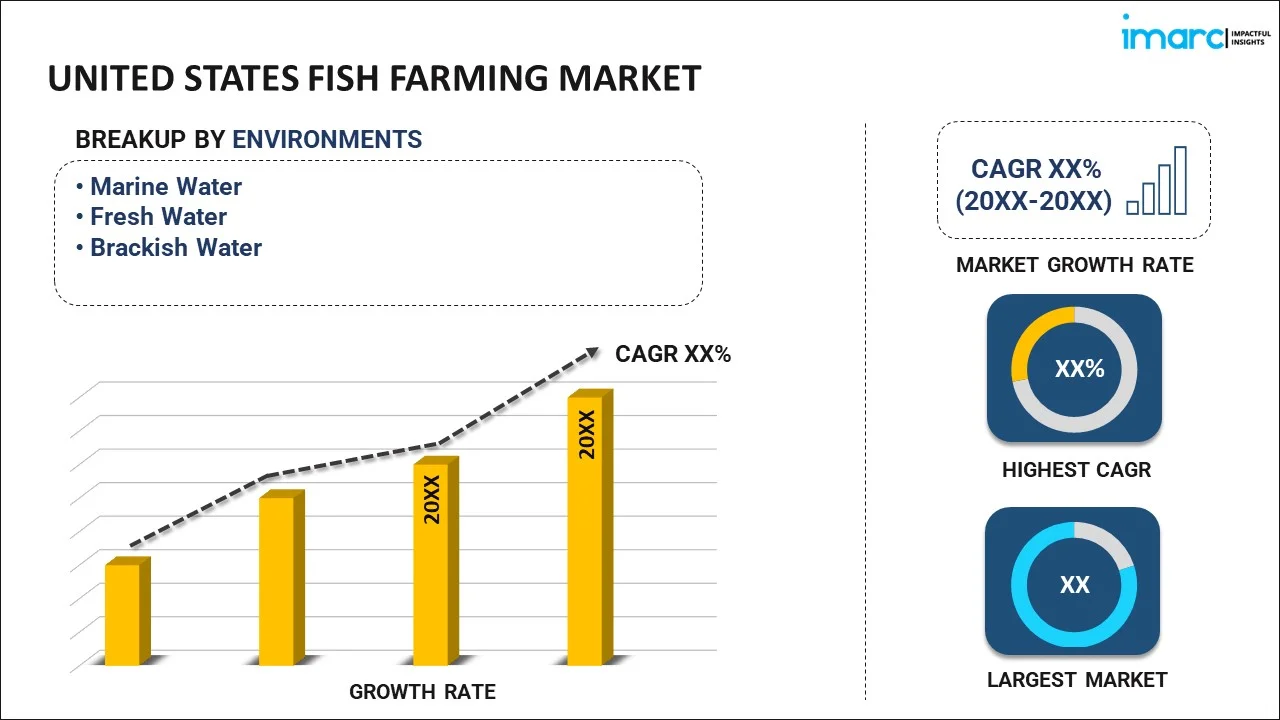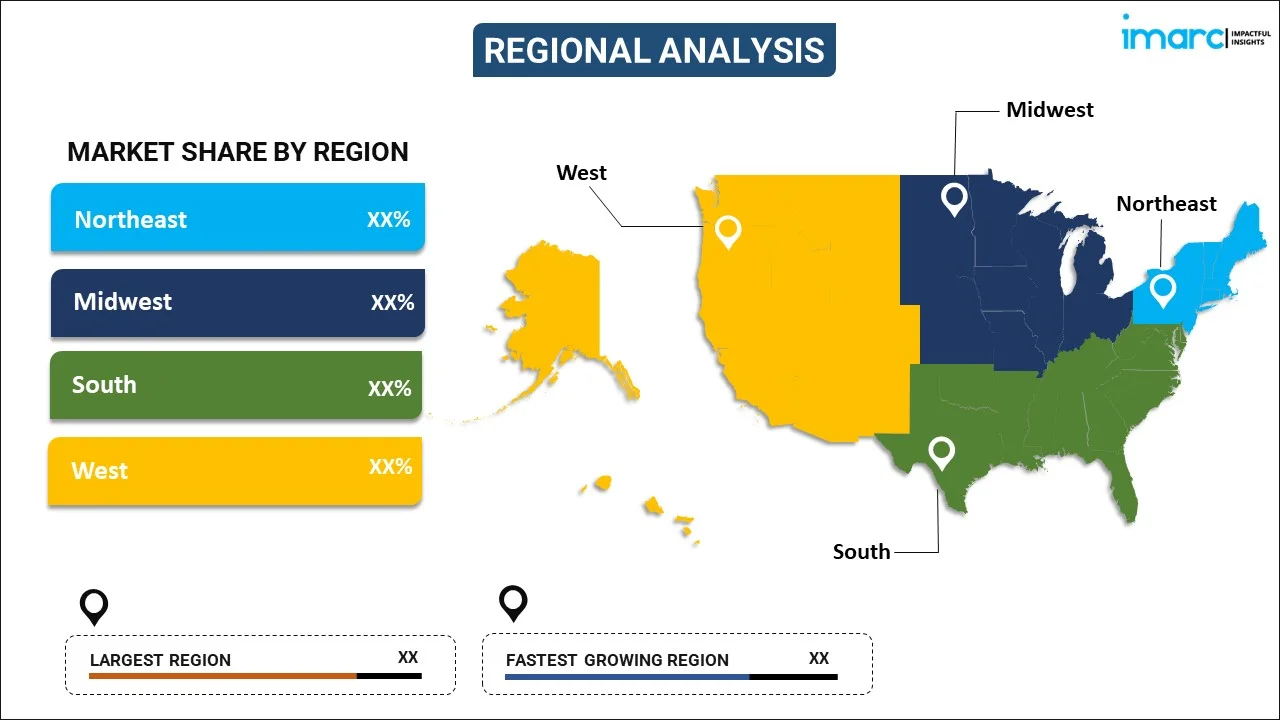
United States Fish Farming Market Report by Environment (Marine Water, Fresh Water, Brackish Water), Fish Type (Salmon, Milkfish, Tuna, Tilapia, Catfish, Sea Bass, and Others), and Region 2025-2033
Market Overview:
The United States fish farming market size reached USD 79.7 Billion in 2024. Looking forward, IMARC Group expects the market to reach USD 120.1 Billion by 2033, exhibiting a growth rate (CAGR) of 4.7% during 2025-2033. The escalating health consciousness among regional consumers, growing demand for sustainable protein sources, recent advancements in fish farming technology, growing concerns over the depletion of wild fish stocks, and implementation of supportive policies by the Government of the United States of America represent some of the key factors driving the market.
|
Report Attribute
|
Key Statistics
|
|---|---|
|
Base Year
|
2024 |
|
Forecast Years
|
2025-2033 |
|
Historical Years
|
2019-2024
|
| Market Size in 2024 | USD 79.7 Billion |
| Market Forecast in 2033 | USD 120.1 Billion |
| Market Growth Rate (2025-2033) | 4.7% |
Fish farming is the systematic cultivation and harvest of various aquatic organisms, such as fish, crustaceans, and mollusks. It is practiced in freshwater, marine, and brackish water environments. It is a process that comprises of multiple steps, such as selecting appropriate sites and species, managing water quality, attending to feeding and breeding, combating diseases, and monitoring growth. It utilizes various specialized tools, such as filtration systems, aeration devices, and containment structures, such as tanks or cages. Fish farming is widely used in a multitude of applications, such as food production, fisheries replenishment, ornamental breeding, recreational fishing, ecosystem restoration, pharmaceutical extraction, educational research, and climate change mitigation. It offers numerous advantages, including the regular provision of high-quality protein, efficient resource utilization, sustainable fishery management, and enhanced food security. Fish farming also alleviates strain on wild stocks, recycles and purifies waste, supports rural economies, diversifies income streams, and furthers scientific research.
United States Fish Farming Market Trends:
The escalating health consciousness among consumers, coupled with the escalating awareness of the health benefits of seafood, is propelling the market growth. Along with this, the growing demand for sustainable protein sources due to escalating concerns over food security is acting as another growth-inducing factor. Furthermore, the recent advancements in fish farming technology, such as automated feeding systems, water quality sensors, and fish health monitoring devices, which enhance productivity, reduce operational costs, and improve fish welfare, are contributing to the market growth. Apart from this, the growing concerns over the depletion of wild fish stocks and the environmental implications of overfishing are further bolstering the market growth. In addition, the imposition of various initiatives and supportive regulations by the Government of the United States of America promoting sustainable aquaculture practices through financial incentives and educational programs is strengthening the market growth. Moreover, the increasing versatility of fish farming, owing to its array of applications in food production, pharmaceutical extraction, and ecosystem restoration, is favoring the market growth. Besides this, the introduction of aquaponics, where fish farming and plant cultivation is carried out simultaneously due to its resource efficiency and waste reduction benefits, is positively influencing the market growth. Along with this, the emerging trends of genetic improvement in fish farming to improve disease resistance and enhance growth rates are favoring the market growth. Additionally, the rising awareness about the role that fish farming plays in climate change mitigation, such as carbon sequestration and energy-efficient protein production, is fueling the market growth.
United States Fish Farming Market Segmentation:
IMARC Group provides an analysis of the key trends in each segment of the United States fish farming market report, along with forecasts at the country level for 2025-2033. Our report has categorized the market based on environment and fish type.
Environment Insights:

- Marine Water
- Fresh Water
- Brackish Water
The report has provided a detailed breakup and analysis of the market based on the environment. This includes marine water, fresh water, and brackish water.
Fish Type Insights:
- Salmon
- Milkfish
- Tuna
- Tilapia
- Catfish
- Sea Bass
- Others
A detailed breakup and analysis of the market based on the fish type has also been provided in the report. This includes salmon, milkfish, tuna, tilapia, catfish, sea bass, and others.
Regional Insights:

- Northeast
- Midwest
- South
- West
The report has also provided a comprehensive analysis of all the major regional markets, which include Northeast, Midwest, South, and West.
Competitive Landscape:
The report has also provided a comprehensive analysis of the competitive landscape in the market. Competitive analysis such as market structure, key player positioning, top winning strategies, competitive dashboard, and company evaluation quadrant has been covered in the report. Also, detailed profiles of all major companies have been provided.
United States Fish farming Market Report Scope:
| Report Features | Details |
|---|---|
| Base Year of the Analysis | 2024 |
| Historical Period | 2019-2024 |
| Forecast Period | 2025-2033 |
| Units | Billion USD |
| Scope of the Report | Exploration of Historical and Forecast Trends, Industry Catalysts and Challenges, Segment-Wise Historical and Predictive Market Assessment:
|
| Environments Covered | Marine Water, Fresh Water, Brackish Water |
| Fish Types Covered | Salmon, Milkfish, Tuna, Tilapia, Catfish, Sea Bass, Others |
| Regions Covered | Northeast, Midwest, South, West |
| Customization Scope | 10% Free Customization |
| Post-Sale Analyst Support | 10-12 Weeks |
| Delivery Format | PDF and Excel through Email (We can also provide the editable version of the report in PPT/Word format on special request) |
Key Questions Answered in This Report:
- How has the United States fish farming market performed so far and how will it perform in the coming years?
- What has been the impact of COVID-19 on the United States fish farming market?
- What is the breakup of the United States fish farming market on the basis of environment?
- What is the breakup of the United States fish farming market on the basis of fish type?
- What are the various stages in the value chain of the United States fish farming market?
- What are the key driving factors and challenges in the United States fish farming market?
- What is the structure of the United States fish farming market and who are the key players?
- What is the degree of competition in the United States fish farming market?
Key Benefits for Stakeholders:
- IMARC’s report offers a comprehensive quantitative analysis of various market segments, historical and current market trends, market forecasts, and dynamics of the United States fish farming market from 2019-2033.
- The research study provides the latest information on the market drivers, challenges, and opportunities in the United States fish farming market.
- Porter's five forces analysis assist stakeholders in assessing the impact of new entrants, competitive rivalry, supplier power, buyer power, and the threat of substitution. It helps stakeholders to analyze the level of competition within the United States fish farming industry and its attractiveness.
- Competitive landscape allows stakeholders to understand their competitive environment and provides an insight into the current positions of key players in the market.
Need more help?
- Speak to our experienced analysts for insights on the current market scenarios.
- Include additional segments and countries to customize the report as per your requirement.
- Gain an unparalleled competitive advantage in your domain by understanding how to utilize the report and positively impacting your operations and revenue.
- For further assistance, please connect with our analysts.
 Inquire Before Buying
Inquire Before Buying
 Speak to an Analyst
Speak to an Analyst
 Request Brochure
Request Brochure
 Request Customization
Request Customization




.webp)




.webp)












